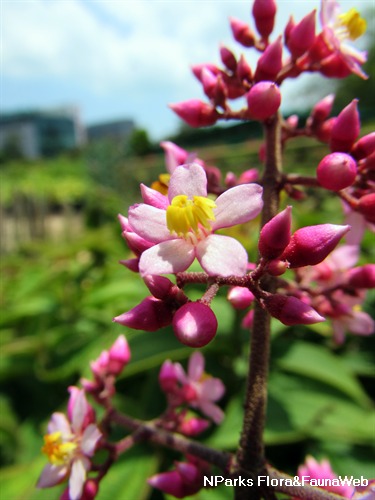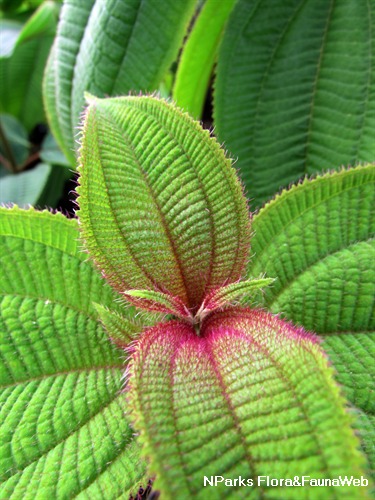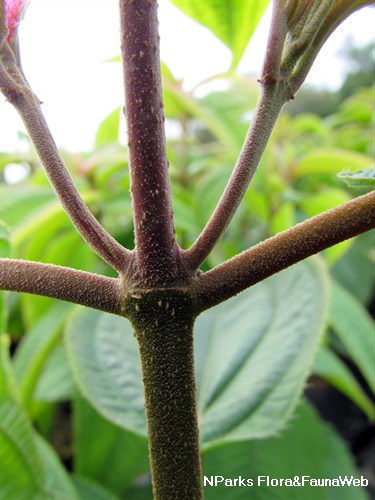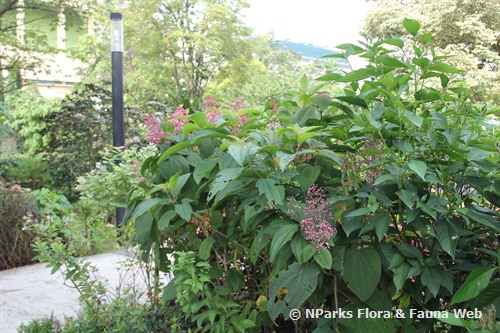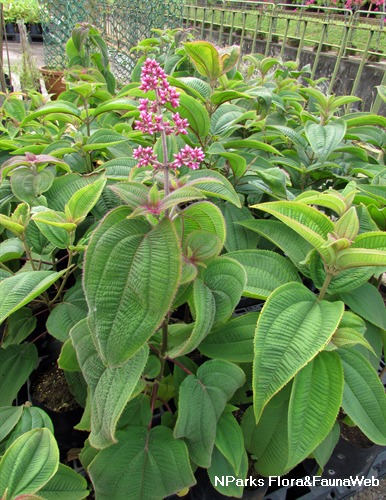
Back
Conostegia subcrustulata (Beurl.) Triana
| Family Name: | Melastomataceae |
| Synonyms: | Miconia subcrustulata Beurl., Conostegia purpurea Griseb |
Conostegia subcrustulata is a shrub to small tree with broad, oval-shaped, softly hairy leaves with finely toothed margins. The young leaves are reddish-pink and turn green upon maturity.
Name
Classifications and Characteristics
| Plant Division | Angiosperms (Flowering Seed Plants) (Dicotyledon) |
|---|---|
| Plant Growth Form | Shrub |
| Lifespan (in Singapore) | Perennial |
| Mode of Nutrition | Autotrophic |
| Maximum Height | 1 m to 5 m |
Biogeography
| Native Distribution | Colombia, Costa Rica, Ecuador, Honduras, Nicaragua, Panama |
|---|---|
| Native Habitat | Terrestrial |
| Preferred Climate Zone | Tropical |
| Local Conservation Status | Non-native (Horticultural / Cultivated Only) |
Description and Ethnobotany
| Growth Form | Shrub to small tree, about 1m – 5m, easily recognized from its broad leaves with serrate margins. |
|---|---|
| Foliage | Leaves are opposite and ovate-shaped, 5 – 21 cm long and 3 –12 cm wide. Both upper and lower surfaces are densely hairy, giving it a rough texture. Mid rib is arched and 2–4 major veins run parallel on each side of it. Numerous minor veins formed ladder-like structure between primaries. Petiole 0.5 - 12 cm. Leaf base rounded to cordate, apex acute or short acuminate. Leaf margin serrate (finely toothed). New leaves are reddish and turn green when matured. |
| Stems | Young stems are greyish-green with fine hairs. |
| Flowers | Terminal panicle is large (6.7 – 30 cm long) with reddish stem. Bright pink pyriform buds, 3 - 6 mm long, are twisted and pointed. Hypanthial area (2.5 mm long) is hairy. Calycine area is almost glabrous. Flowers are pink and radially symmetrical, with smooth petals about 0.5 cm long, 0.3 cm wide. Flowers are bisexual and each consists of inferior ovary, sickle-shaped anthers, 4 mm style and 8–10 yellow stamens. <2> |
| Fruit | Fleshy berry turning from pink to dark purple to black at maturity. Seeds are small, about 1 - 1.5 mm long, narrowly wedge-shaped, glossy on one side and smooth on the other. Berries of this species are produced directly after flowering, unlike some others with fruiting that occurs several months after flowering (eg. C. pittieri and C. rufescens) |
| Habitat | Seasonally dry to wet regions, in open sites, roadsides, pastures. |
| Associated Fauna | In Costa Rica, flowers are commonly visited by bees of the genus Melipona and Euglossa |
Landscaping Features
| Landscaping | Suitable for growing in parks and gardens for its ornamental pink flowers and reddish new leaves. |
|---|---|
| Desirable Plant Features | Ornamental Flowers, Ornamental Foliage |
| Landscape Uses | Parks & Gardens |
Fauna, Pollination and Dispersal
| Fauna Pollination Dispersal Associated Fauna | Bird-Attracting (Fruits) |
|---|---|
| Seed or Spore Dispersal | Biotic (Fauna) (Vertebrates (Other Mammal)) |
Plant Care and Propagation
| Light Preference | Full Sun |
|---|---|
| Water Preference | Moderate Water |
| Plant Growth Rate | Fast to Moderate |
| Rootzone Tolerance | Well-Drained Soils |
| Potential Problems | Pest problems like Thrips (Frankliniella standleyana) |
| Pest(s) | Sucking Insects |
| Propagation Method | Seed |
Foliar
| Foliage Retention | Evergreen |
|---|---|
| Mature Foliage Colour(s) | Green |
| Mature Foliage Texture(s) | Velvety / Furry / Tomentose, Hairy / Hirsute |
| Prominent Young Flush Colour(s) | Red, Pink |
| Young Flush Texture(s) | Velvety / Furry / Tomentose, Hairy / Hirsute |
| Foliar Type | Simple / Unifoliate |
| Foliar Arrangement Along Stem | Opposite |
| Foliar Attachment to Stem | Petiolate |
| Foliar Shape(s) | Non-Palm Foliage (Ovate, Oblong) |
| Foliar Venation | Pinnate / Net |
| Foliar Margin | Serrate / Toothed |
| Foliar Apex - Tip | Acute |
| Foliar Base | Rounded / Obtuse |
Non - Foliar and Storage
| Stem Type & Modification | Herbaceous |
|---|---|
| Root Type | Underground |
Floral (Angiosperm)
| Flower & Plant Sexuality | Bisexual Flowers |
| Flower Colour(s) | Pink |
|---|---|
| Flower Texture(s) | Smooth |
| Flower Grouping | Cluster / Inflorescence |
| Flower Location | Terminal |
| Flower Symmetry | Radial |
| Individual Flower Shape | Stellate / Star-shaped |
| Inflorescence Type | Panicle |
Fruit, Seed and Spore
| Mature Fruit Colour(s) | Black |
|---|---|
| Fruit Type | Fleshy Fruit |
| Seed Quantity Per Fruit | Numerous (>20) |
References
| References | <1> Kriebel, R. (2016). A monograph of <i>Conostegia</i> (Melastomataceae, Miconieae). PhytoKeys 67:1-326. Accessed on 27 June 2024 from https://phytokeys.pensoft.net/article/6703/list/9/ <2> Schnell, C.E. (1996). The genus <i>Conostegia</i> (Melastomataceae). PhD thesis, Harvard University. |
|---|
Image Repository
Others
| Master ID | 32270 |
|---|---|
| Species ID | 6678 |
| Flora Disclaimer | The information in this website has been compiled from reliable sources, such as reference works on medicinal plants. It is not a substitute for medical advice or treatment and NParks does not purport to provide any medical advice. Readers should always consult his/her physician before using or consuming a plant for medicinal purposes. |


